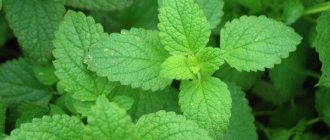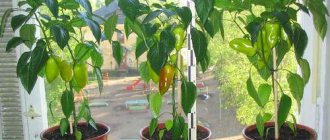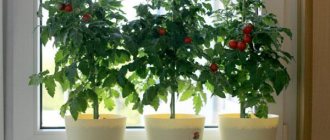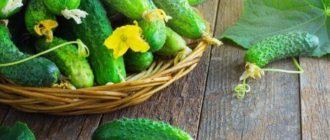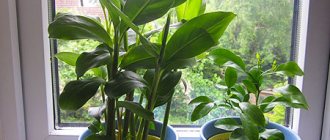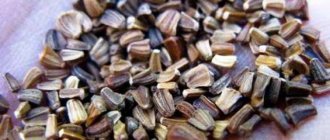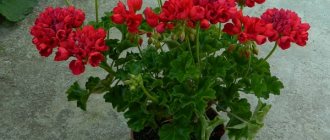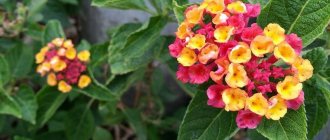The herbaceous perennial plant peppermint (Mentha piperita), or English mint, or chilli, or cold mint, or peppermint, is a species of the genus Mint, belonging to the family Lamiaceae (Lamiaceae). This species was obtained through the hybridization of watermint and spearmint (garden). This plant was considered very valuable back in the days of Ancient Rome; furniture was rubbed with its leaves, and mint infusion was used to spray rooms. In ancient Egypt, mint was placed in the tomb of the pharaohs. This culture was named after the nymph Menta, transformed into a bush with a pleasant, delicate, but very cold aroma. Mint is very popular in English cuisine, where it is used as a spice for lamb sauce. In America, this plant is used as an ingredient in vegetable or fruit salads, and also as an additive to mixed drinks and tomato juice. Peppermint is also used to make medicines with various effects.
Mint varieties
A wide variety of mint varieties allows you to choose the most suitable plant for your home or summer cottage.
Peppermint is especially popular due to its high essential oil content and rich menthol aroma. The root system is branched, woody, and is located horizontally in the soil. There is a wide variety of mint species (up to 25 species). Many varieties are bred artificially. Each variety of plant has its own strong, pleasant aroma and taste.
https://www.youtube.com/watch?v=c4QL4Y7OUr8
The most common is peppermint. Due to the high content of essential oils, it is used more often than others in medicine, cooking, and cosmetology. The variety was obtained by crossing water mint and garden mint. It has an unusual taste, slightly hot and cooling.
Other varieties include white, apple, curly, water, flea, field, long-leaf, and spearmint. Mint also grows with the aroma of banana, strawberry, ginger, pineapple, chocolate, and lemon.
Types and varieties of mint with photos and names
Almost 25 species and 10 subspecies of peppermint are known. The most popular ones will be described below:
mint
The height of the powerful bush is about 0.9 m. This species does not have the strong cooling effect that peppermint has, since the main component of this plant is an essential oil called carvone. This mint is added to soft drinks and tea, and is also used to flavor toothpaste.
Curly mint
The height of the plant is from 0.8 to 0.9 m. This mint, unlike other species, has curly foliage and is highly resistant to frost. Its leaves do not have the strong menthol flavor of peppermint. This plant is quite popular in cooking, and it is also used in alternative medicine, for example, a decoction of the leaves is used as a sedative, to relieve pain from injuries and for healing baths.
Apple mint
The height of the bush is about 0.6 m. The dark green velvety leaf plates have a rounded shape. The smell of this plant is not very strong compared to the aroma of peppermint. This mint is used to add to meat dishes, a variety of drinks, soups and salads, as well as to baked goods and desserts.
Longleaf mint
The height of the powerful bush is about one and a half meters. Its rhizome is creeping, and its shoots are tetrahedral and dissected. The color of the leaf blades is dark green, and their edge is serrated-toothed. The bushes have a delicate and pleasant smell, so this mint is used as an additive to vegetable broths, salads and soups, as well as to some meat dishes, for example, fried beef or shish kebab. The foliage of this plant is added to the marinade when preserving eggplants, and is also used as a spice when pickling cabbage. This type is also used in the perfume industry, in particular in soap making.
Field mint, or horsemint, or wild, or deaf
This species is widespread in nature and is therefore found everywhere. The height of the bushes is about 0.8 meters. The foliage does not have the strong aroma and cooling menthol taste that peppermint has. Dried or fresh leaves are used as an additive in various drinks, for example, tea, placed in baked goods, fish dishes, salads, vegetable soups and in cabbage during pickling. A decoction of this plant is used to treat inflammation and headaches.
Lemon mint
The height of the plant is about 100 centimeters. Branched, erect shoots have slight pubescence. The opposite leaf blades have a rounded-ovoid shape and a jagged edge. The front surface of the leaves is dark green in color, and the underside has a paler shade. This species has a pleasant mint-lemon smell, as well as medicinal properties. This species also has a second name - lemon balm.
Sweet mint
This perennial plant has a stable, erect stem reaching 0.4–1 meters in height. The wrinkled leaf blades are green and have a creamy stripe along their edge. These leaves have a pleasant smell. This mint is widely used in cooking, and for a long time it has been used in folk medicine, as it has healing properties.
Did you know how many varieties of MINT there are?
In addition to these species, gardeners cultivate house mint, Moroccan mint, Korean mint, orange mint (bergamot mint), dog mint, steppe mint, water mint, etc.
Peppermint is different from all other types; it is grown on an industrial scale. There are a very large number of hybrids and varieties of this species, which are very diverse. The most popular varieties and hybrids are:
- Prilukskaya 6 . This variety has been known for a very long time; its growing season lasts approximately 100 days. Its shoots are covered with a large number of leaves. The leaf blades contain about 50 percent menthol and about 3 percent essential oil.
- Medicinal 4 . The height of the powerful bush is about 100 centimeters, and the duration of the growing season is approximately 115 days. The leaf blades have an anthocyanin color and contain approximately 60 percent menthol and about 4 percent essential oil.
- Mystery . This variety was created by Ukrainian breeders. Green leaf blades do not have anthocyanin color. The duration of the growing season for this variety is approximately 110 days. The leaves contain up to 65 percent menthol and 3.5 percent essential oil.
- Charm . The variety was created by Belarusian breeders. The height of the bush is about 0.7 m, its lower part is purple-red in color. This variety exhibits seed formation, so scientists doubt that it is related to the peppermint species.
- Ukrainian pepper . The variety is characterized by high yield and resistance to drought and disease. The foliage contains about 53 percent menthol and about 61 percent essential oil.
- Udaychanka . This high-yielding non-lodging variety is resistant to cold weather. The essential oil contains about 47–52 percent menthol.
The following varieties of peppermint are quite popular among gardeners: Simferopolskaya 200, Zagrava, Zarya, Vysokomentholnaya, Serebristaya, Yantarnaya, Medichka, Moskvichka, Krasnodarskaya 2, Kubanskaya 6, etc.
Description
The aromatic herbaceous plant mint is familiar to everyone. It is grown in the garden and at home. Mint leaves are widely used for medicinal purposes and also in cooking as a spice.
Sweetgrass has a strong root system that grows well and serrated leaves that are bright green. The plant is easy to care for and can grow on the site along with weeds. Species diversity includes more than 100 species.
Mint should be grown separately from other crops, especially those that require chemical treatment. The leaves and flowers of the fragrant plant are unsuitable for consumption after spraying. The rapid proliferation of mint bushes will displace neighboring crops from the site.
Description of the plant
Peppermint is an aromatic plant; its essential oil is used in perfumery, medicine and cosmetology. It is a bush with a height of 35–110 cm. Mint raw materials contain a lot of menthol, carotene, tannins and resins, glucose, saponins and several types of natural acids (caffeic, ascorbic, chlorogenic, oleanolic and ursolic).
Why is mint dangerous in the garden?
When planting mint on your site, you should take into account one feature: the root system of the plant grows very quickly, gradually filling the entire nearby area. To remove the spice from the garden, you will have to dig deep into the entire area.
There is another option to protect the soil from the endlessly growing roots of the plant. Mint is planted in a separate container (a basin or bucket will do). The selected container is dug into the ground, leaving a small rim. Growing it will not cause unnecessary trouble, and you can plant other crops nearby without fear that the mint roots will interfere.
What conditions does mint need for successful growth?
Mint is a perennial, so to grow it you need to immediately create the necessary conditions. It is important to decide where to plant mint on the site, which plants will feel comfortable nearby, what requirements mint makes for soil composition, lighting, and watering.
It is best to plant mint in an area previously occupied by legumes and root crops. Plants such as, say, buckwheat or melon are also considered good precursors for mint, since they tend to saturate the soil with calcium necessary for the normal growth of mint.
When choosing where to plant mint next to, you should keep in mind that any pesticides exclude the possibility of consuming this plant, so there should be no flowers, vegetables, or other valuable crops in the immediate vicinity of mint.
Features of choosing lighting for mint
For mint, you need to choose a warm, sunny place, protected at the same time from the scorching midday rays. Mint is a moisture-loving plant, so it does not tolerate drying out very well.
The sun should illuminate the mint for at least four hours a day, while in the middle of the day it is better for the plant to be in partial shade. The south, southwest or east side is optimal for growing mint indoors.
Long daylight hours accelerate the development of mint, so if the plant is intended for sale, the time of active lighting of the area can be artificially increased. If there is not enough sun on the site, this will not be a serious obstacle to the growth of mint, provided that the plant is not oversaturated with moisture.
What kind of soil should there be for growing mint?
Mint needs to be provided with light, loose soil with a moist and deep fertile layer.
The pH level should be in the range of 6.0-7.0. Sandy loam soils and loam are suitable for the plant. Mint does not take root in swampy soils.
To prevent the soil from drying out, it is recommended to use mulching.
The plant needs organic, nitrogen and phosphorus fertilizers. You can feed mint 1-2 times a month.
The soil on which mint grows should be dug well twice a year and weeds should be constantly weeded out, as they can damage the root system of the plant.
Planting in open ground
Mint prefers light, loose and fertile soil. In heavy and clayey soils, as well as in places with stagnant moisture, the grass does not take root or grows very poorly. The plant is well suited to sandy or loamy soil rich in humus. The optimal soil acidity level is 6.0 – 7.0.
Before planting, the soil must be thoroughly dug up and the area cleared of weeds. You need to try to get rid of weeds immediately so that their root system does not interfere with the rooting of mint.
To enrich the soil with elements useful for growth, during the digging process you need to add the following fertilizers to the soil per 1 square meter. m:
- humus – 3 kg;
- superphosphate – 15 g;
- ammonium nitrate – 15 g;
- potassium chloride – 15 g;
- wood ash – 30 g.
To prevent the plant from growing, you can put restrictions by digging sheets of slate or iron into the ground to a depth of 30 - 40 cm. As a result, the root system of the plant will be within the fence and will not interfere with the growth of other crops.
It is necessary to limit the spread of roots in the soil when mint is planted in a flower bed for decorative purposes. If this is not done, the grass will very soon fill the free space and begin to crowd out the flowers. To make mint look aesthetically pleasing and not interfere with the growth of other plants, it can be dug into a flowerbed along with a pot, which will limit the spread of roots, and the bush will have a neat appearance.
To ensure that the mint beds look neat and the plants are thick and low, you need to pinch the tops 10-15 days after planting the seedlings. Proper pinching is carried out when the plant has reached 20 - 25 cm in height.
There are several ways to plant mint:
- Seeds begin to be sown in early spring. Furrows with a depth of 5 millimeters are made in the area. The planting material is lightly pressed and covered with a small layer of soil with the addition of humus. After this, it is recommended to cover the planting with film. Planted seeds are periodically ventilated and watered. If these rules are followed, the first shoots should appear in 2.5 weeks. Comfortable temperature is 23 degrees.
- For propagation, root or stem cuttings are used. Propagation is carried out by stem cuttings. A shoot equal to 8 centimeters is cut from the plant. The cuttings can be placed in water until roots appear or planted in sand. Sprouted cuttings with roots 9 centimeters deep into the soil by 5 centimeters, the distance between them is 15 centimeters. Propagation is practiced using root cuttings. Each cutting should have at least one bud and 4-5 leaves. The separated cuttings are immediately planted in the prepared hole and sprinkled with earth.
- Planting is also done by dividing the bush. An adult plant is dug up along with its roots and divided into parts. It is important that each part has a bud and shoots with regrown roots.
You can also transplant seedlings grown at home to a permanent place:
- Initially, the seeds are germinated by wrapping them in damp cloth. The seeds are kept in this form in a warm room for several days.
- As soon as the first shoots hatch, the seeds are planted in containers with soil to a depth of 6 millimeters.
- The containers are covered with film for 6-7 days.
- After the sprouts appear, the strongest of them are transplanted into separate containers and stored in a cool room.
- The strengthened sprouts are transplanted to a permanent place.
After planting in open beds, they continue caring for the plant. To make the bushes lush, pinch the tops at a height of 24 centimeters. If you constantly remove flowers, then there is a better growth of green leaves.
Properties of mint: harm and benefit
Medicinal properties of mint
The flowers, foliage and stems of mint contain bitter, tannin and biologically active substances, fats, sugars, phytoncides, vitamins C and P, mineral salts, carotene, and essential oil, which includes menthol.
This plant is used in both official and alternative medicine for nervous disorders, headaches, toothaches, asthma, throat diseases, cardiovascular diseases, insomnia, neuralgia, inflammation of the digestive system, colds, bronchitis, atherosclerosis and others. diseases.
Menthol has an analgesic, antimicrobial and antispasmodic effect. It is recommended to take this plant internally to dilate the coronary vessels in case of angina pectoris or pain in the stomach or intestines. External use of mint is recommended for bronchitis, neuralgia or toothache. Menthol is found in ointments for the common cold, mouth rinses, Zelenin drops and valocordin.
Tinctures and infusions are prepared from the leaves of such a plant, which can improve digestion, increase appetite and relieve vomiting and nausea. Medicines containing mint are used as a pain reliever for hepatic colic, as choleretic drugs for gallstones or jaundice, and also as a means to stimulate the heart.
In Germany, the foliage of this plant is included in medicinal teas used for flatulence and diseases of the gastrointestinal tract. Baths with mint are also popular in this country. Peppermint is used in Australia to make tinctures and infusions. The foliage of this plant in Poland is used in the treatment of inflammation of the periosteum, middle ear, as well as for migraines, insomnia and neuralgia. Mint is included in preparations intended to improve smell and taste. In Russia, in alternative medicine, mint leaves are used as a choleretic, diaphoretic and refreshing agent.
Wild mint leaves are used to make juice used in the treatment of kidney stones. If such juice is mixed with white wine, then this mixture will have a diuretic effect. This plant is found in stomach preparations, teas and bath preparations. It is also widely used in the perfume industry and cooking.
Mint - beneficial properties and uses. USING mint for health and beauty
Contraindications
Some people have an individual intolerance to mint and products that contain it. This plant can cause an allergic reaction. Peppermint oil should not be used during pregnancy or breastfeeding, and should not be given to children under 6 years of age. Peppermint products should not be used in large quantities by men, as this type helps reduce libido.
If you overdose on products made from mint, a person may experience pain in the heart, bronchospasms and sleep disturbances.
Recipes
Below we will describe popular mint recipes that will be useful to everyone:
- Infusion for bad odor from the mouth . 2 tbsp. just boiled water must be combined with 1 tbsp. l. mint leaves. After a couple of hours, the infusion will be ready; it is used to rinse the mouth.
- Infusion for nausea . 1 tbsp. just boiled water must be combined with 1 tbsp. l. mint leaves, wrap the container. After 30–40 min. the infusion will be ready. The strained product is taken 1 tbsp. l. every 3 hours for abdominal pain or nausea. And when vomiting, drink ½ tbsp. facilities.
- Tincture for headaches . Combine alcohol (70%) and crushed leaf plates in a ratio of 20:1. The tincture will be ready after 7 days. For headaches or nausea, you should drink 10–15 drops of this tincture.
Mint planting dates
Mint is a frost-resistant plant. Planting is allowed in early spring and even late autumn. The main thing is that each season requires a certain planting method:
- The plant should be planted with seeds in early spring. Over the summer it takes root and withstands bad weather.
- In summer, planting is done by cuttings.
- Autumn replanting is carried out only by cuttings. To prepare the plant for winter, mulch the soil. Sawdust or peat are suitable as mulch. The layer should be thick, at least 15 centimeters.
The latest way in which a plant can be propagated is by dividing the bush. Planting is possible even a few days before the onset of frost.
Features of growing mint on the window
Growing mint on a windowsill does not require effort or special skills. You can grow indoor spices throughout the year, but it is advisable to plant them in the autumn or spring months.
The optimal place for summer keeping is a balcony, for winter – a window sill, where there is good lighting. Depending on the size of the bush, it can be placed on a shelf or on the floor. It is advisable to water from a tray with slightly warm boiled water. The leaves are periodically sprayed and cleaned of dust accumulations: this helps to enhance the aroma.
In winter, the plant is dormant and grows slowly. It must be protected from cold and drafts. During the warm period, when growth processes are activated, the upper leaves should be cut off, leaving 2 cm of petiole from the stem: this is necessary to stimulate the appearance of lateral shoots.
Mint propagation
Mint can be propagated at home and on the site in several ways:
- By dividing the rhizome.
- By cuttings.
- Seeds.
The abundant growth of the root system makes it easy to propagate mint by dividing the rhizome. This method is quite simple and is often used in gardening. The mint bush must be carefully dug up without damaging the roots. Before starting propagation, it is recommended to dry the plant.
The root must be separated so that at least 10 nodules remain on it. The seedling can be immediately transplanted to a new location by preparing planting holes about 15 cm deep in advance. To ensure that the bush takes root better, a layer of humus is placed on the bottom of the hole. You can add superphosphate, potassium chloride and wood ash to the soil. Mint is planted in moist soil, after which the soil is compacted and the plant is watered at the root.
- For propagation by cuttings, select the strongest and healthiest branches, which are cut to 10–15 cm. The cutting must have at least 2 leaf rosettes.
- The twig needs to be placed in a container with clean water at room temperature for rooting. In order for the roots to develop faster, the cuttings can be placed for 2 - 3 days in a solution of the Kornevin preparation, and then in clean water. The water needs to be changed every few days to prevent it from stagnating.
- The plant should be planted in the ground after roots have formed 2–3 cm in size. On average, the depth of the hole for planting cuttings should be 5 cm. It is not recommended to bury the seedling too deeply into the soil.
Growing mint from seeds is more difficult than propagating bushes by cuttings or dividing roots. In open ground, seeds may not germinate, so it is recommended to sow at home. It is best to purchase seed material at a flower shop. Self-collected seeds do not always inherit the characteristics of a hybrid, and wild varieties without any decorative characteristics can grow from them.
Before sowing, the soil is also treated to remove pathogens, fungi and pests. To do this, the soil is dried in an oven at a temperature of 150... 200 degrees or poured with boiling water. At a flower shop you can purchase a special soil mixture enriched with microelements necessary for healthy plant growth.
Sowing is carried out in slightly moistened soil, after which the soil is irrigated from a spray bottle with water at room temperature. To make it more convenient to place the seeds in the soil, you can use a wooden stick or a special syringe for seeds. The distance between seedlings should be 3–5 cm.
- Planting containers should be stored at a temperature of 22 ... 25 degrees, the optimal air humidity for germination of mint seeds is 60 - 80%. Containers should not be placed in direct sunlight on a window or near heating appliances. If the air in the room is too dry, you need to place a container of water next to the seedlings.
- Before emergence, you need to ensure that the soil in the container is constantly moist. If the soil dries out, the seeds may die and will not germinate.
- To better retain moisture in the soil, planting containers can be covered with cling film, which must be removed after the seeds hatch to the surface.
- When real leaves appear on the seedlings, you should begin replanting. Mint is planted in open ground in the spring, not earlier than mid-April, when the soil warms up well.
- At home, seedlings are planted in pots.
- After the plant reaches 15–20 cm in height, you need to pinch the tops so that the indoor bush does not stretch upward.
- In the warm season, containers with weed can be placed on the balcony, and in winter, the pots can be moved to the windowsill.
Peppermint and curly mint varieties are suitable for growing in an apartment. It is not recommended to plant “catnip” in pots, since this variety grows wild and may not take root at home.
How to plant mint in the country
Although experienced gardeners know how to plant mint seeds in open ground, beginners in this matter may have some questions. In fact, the plant will easily and quickly reproduce in this way if you follow a certain sequence of actions:
- A suitable excavated area is selected and shallow grooves are prepared on it.
- The rows must be arranged in such a way that there is at least 30 cm of space between them. The fact is that mint bushes grow quickly, and if planted closely, they will then have to be replanted.
- It is necessary to place seeds in the soil not too often so that neighboring roots do not interfere with each other.
- When the first shoots emerge, you should check that they are not growing too closely. If necessary, excess ones must be removed.
Find out which apple trees are best to plant in your dacha
Additional Information! The removed seedlings do not have to be thrown away - they can be planted in another place.
Selecting a site
Planting material serves as the basis for the future harvest. Therefore, special attention is paid to the selection of seeds and cuttings.
It is best to buy mint seeds for planting in special stores. On your own, even if you manage to collect seeds, it is unlikely that you will be able to grow a high-quality plant from them. Mint will have characteristics that are far from the original version.
It is easier to grow seedlings not from seeds, but from shoots cut from an adult bush. The side branch that extends from the central stem is cut at a distance of 1.5 centimeters from the central stem. The shoot is placed in a glass of water. As soon as it takes root, you can start planting it in the soil.
Only healthy plants with straight leaves and strong stems are suitable as seedlings. You should not choose for planting bushes with limp, wrinkled leaves damaged by pests.
You need to choose an area that is well lit by sunlight, but not direct. Therefore, at midday it is better if the area is in the shade.
The soil on the site should be fertile, loose with good aeration. If the acidity is high, then the soil is first limed (lime or wood ash is added). Loamy, sandy loam or black soil in the floodplain of a reservoir is considered ideal.
How to choose quality planting material
Planting material for planting mint can be obtained in various ways - purchased in a store or nursery, ordered online, made yourself (if you are already growing this plant) or asked from trustworthy friends. Each of these methods has its own advantages and disadvantages; the final decision depends on many factors.
Selecting seeds for planting
Self-collection of seeds from the mother plant is a rather painstaking and complex process. In addition, artificially created varieties of mint often produce seeds from which it is not the mother plant that grows, but a completely different variety - from those used by breeders to breed the hybrid.
First of all, this danger applies to peppermint, which, as you know, is the most popular among gardeners. Of the curly mint seeds, approximately two thirds do not inherit curliness and are a common wild variety.
Therefore, it is recommended to buy seeds for planting mint in specialized stores (it is better, of course, that the manufacturer is reliable and proven); such seeds produce stronger and more friendly shoots.
How to choose mint seedlings
Mint does not propagate well from seeds, so it is better to leave this task to experienced gardeners. It is much easier to purchase ready-made mint seedlings, especially since there are many options for this.
A specialized store is a place where, as a rule, several varieties of seedlings are presented, from which you can choose a plant to suit your taste. The same applies to farmers' markets, however, purchasing seedlings from unverified breeders is dangerous because the plants can be infected with pests or diseases, which can subsequently not only destroy the seedlings, but also cause serious harm to other inhabitants of the garden plot.
As material for future seedlings, you can use an ordinary shoot from an adult plant, which is available at your neighbor’s dacha or in a friend’s pot. To do this, cut off the sprout with a sharp knife or scissors at a height of 1 cm from the junction with the trunk of the mother plant. This sprout is placed in a glass of water, and when the white roots it shoots reach 5 cm in length, the seedlings are ready!
The same procedure can be done using mint, which is sold in the produce departments of supermarkets or at the market. This method does not guarantee a good result, but, in the absence of other options, it can be used as an experiment.
When choosing mint seedlings, you should pay attention to its appearance. Plants should not be lethargic or dried out, the height of the shoots should not exceed 6-8 cm, otherwise it will be difficult for the plant to take root.
General rules for caring for mint
You can plant mint in open ground in spring and autumn, after which the plant must be provided with proper care.
- Autumn planting should be done in late September - early November so that the grass can take root before the onset of cold weather. To avoid freezing of the root system, young plantings should be mulched with a layer of peat or sawdust 15–20 cm thick. In the spring, mint is planted after the soil has warmed up well and the threat of frost has passed.
- After planting, it is necessary to regularly water the bushes so that they take root well and take root in their new location. Watering should be done as the soil dries out.
- Mint loves moist soil, but should not be allowed to soak for long periods of time. High humidity leads to rotting of the root system and fungal infections. Regular watering should be organized during periods of drought so that the plant does not begin to wither and wither. Water for irrigation should be at ambient temperature. Cold spring water negatively affects plant health. Watering should be done in the evening.
- At the beginning of spring, mint can be cut off at the root so that it bushes better and does not stretch in height. The bushes need to be replanted periodically; grass can grow in one place for no more than 5 years.
- Overgrown plantings need to be thinned out and weeds removed regularly to ensure normal air access to the mint roots. The soil needs to be loosened periodically to prevent a crust from forming on it.
Like other crops, mint needs fertilizer and feeding. Mineral fertilizer complexes, which can be purchased at a flower shop, will help saturate the soil with nutrients and microelements.
Fertilizing mint should be done in early spring, as well as in summer, when the plant is actively growing foliage and blooming. Autumn fertilizing is carried out before frosts. To do this, rotted manure is added to the soil in an amount of 2 kg per 1 square meter. m landing.
Mint is an unpretentious plant and does not have any special requirements during cultivation. A standard set of actions is enough:
- Mint loves moisture, but do not flood the area.
- The plant is periodically fed with nitrogen, phosphorus and organic components.
- Be sure to weed the rows to prevent weeds from growing.
- To protect against frost, it is recommended to mulch the soil with straw or spruce branches.
- In spring, the bushes are cut at the root.
In one area, mint can grow for up to 11 years. But many gardeners recommend changing the planting location every 3-4 years, since the roots are destroyed by weeds and pests. The plant becomes weak, loses its aroma and pleasant taste.
Features of peppermint
Mint has a horizontal branched rhizome with thin fibrous roots. The hollow, straight, erect tetrahedral stem has a height of 0.3 to 1 m and is covered with short hairs. Crosswise opposite short-petioled leaf plates have an ovoid oblong shape, heart-shaped at the base and pointed towards the tip, with a sharp-serrated edge. The front surface of the leaves is dark green, and the back surface is paler in color. The length of the plates is 30–50 mm, and their width is 15–20 mm. Spike-shaped inflorescences consist of small lilac flowers. Flowering lasts from the last days of June to September. The fruit contains 4 coenobium nuts. But the formation of such fruits occurs extremely rarely. This plant is a valuable honey plant, and the honey obtained from it has an amber color and a distinct mint smell.
Diseases and pests of mint
Mint is attacked by slugs, mint flea beetles, weevils, mint leaf beetles, whiteflies and mites. Among the diseases, there is a high probability of infection with powdery mildew, anthracnose, and rust.
You can treat plants against pests with ready-made insecticides. They are used once a season and only in case of severe defeat. It is important to remember that the treatment is carried out a month before the expected harvest.
Preventive measures include maintaining crop rotation, deep digging of the soil and removing all plant debris from the site. As a preventative measure, you can use a solution based on celandine and soap.
If improperly cared for and the growing conditions are violated, mint can be susceptible to diseases and pest attacks.
- Most often, the plant is affected by powdery mildew, to combat which a solution of colloidal sulfur is used. The appearance of the disease is indicated by a white coating on the leaves in the form of a cobweb. The disease is caused by too dense plantings, as well as weeds. To avoid infection, it is necessary to regularly weed and thin out the bushes.
- Rust begins to spread from the root system and forms bright red spots on the inside of the leaf. Affected plants must be dug up so that the disease does not spread to healthy bushes.
- The mint flea beetle damages the leaves and roots of the plant. Small yellow bugs measuring 1.5 mm gnaw holes in the leaf blade. Massive flea infestation occurs in dry weather, especially in spring, when the aromatic grass does not receive enough moisture. To avoid insect attacks, it is necessary to organize regular watering, weeding and loosening of the soil.
- The leaf beetle makes holes along the edges of the leaf blade. Beetles measuring 8–10 mm in size, metallic green in color, grow in places with high humidity - in lowlands and in areas with stagnant water. Frequent, abundant watering or an unsuccessful place for planting mint can provoke the appearance of insects on the site.
Diseases and pests should be controlled using preventive methods. It is not recommended to treat mint plantings with chemicals and insecticides, since the herb will become unsuitable for consumption in fresh and dry form. Proper care allows you to make plants healthy and strong, while maintaining the decorative and attractive appearance of the crop.
How to grow mint seedlings at home is described in detail in the video.
Mint diseases
The most destructive disease for plants is rust. The infection is caused by a fungus, for which the ideal conditions for reproduction are low temperatures and a high percentage of moisture in the soil layer. Rust also appears when there is an excessive amount of nitrogenous fertilizers. It is characterized by the formation of small pimples that are dark red in color. They can be found on the lower parts of the leaves.
The next pest is called powdery mildew and appears as a whitish coating affecting the stems and leaves of mint. The most frequent outbreaks of the disease occur in the second half of summer. For protection, plants are treated with colloidal sulfur in the form of a 1% solution. Also in the fall you need to dig up the beds to a depth of at least 20 cm.
Overgrowth is the most dangerous disease caused by mycoplasmas. The growth and development of mint stops, the color of the leaves changes, and the root system stops developing. This scourge cannot be treated, and therefore, in order not to destroy the crop, it is necessary to get rid of diseased plants, and those that remain healthy need immediate replanting.
Collection and storage
The plant can be harvested for fresh use when the bushes reach 25 centimeters in height, which is approximately 2.5 weeks after the first shoots appear. You can pick only the leaves or the entire stem with side branches.
If you plan to dry the branches, it is better to wait until the flowering period. At this time, more essential oils accumulate.
https://www.youtube.com/watch?v=9242blD8N-s
The harvested crop is laid out on a flat surface in one layer. Leave in this position until completely dry in the shade. Dried herbs should be stored in closed containers in a dark and cool place.
How does mint propagate?
There are several ways to grow mint:
- Using seeds.
- Seedlings.
- Vegetative division (cuttings, dividing the bush, rhizomes).
Mint is a very hardy plant, so getting new plantings is quite easy.
Seed method
It is difficult to grow mint seeds due to the following problems:
- poor germination;
- not suitable for hybrid varieties;
- 3 transplants will be needed.
It is recommended to use an enriched soil composition: 1 kg of sand and compost per 2 kg of soil. Before sowing mint, the seed material is soaked for 30 minutes in a slightly pink solution of potassium permanganate (a pinch the size of a poppy seed is diluted in 1 liter of boiled warm water), and then dried on paper for several hours.
Seeds for germination are sown in trays in moistened soil, to a depth of 0.5 cm. Leaving the seeds to germinate, the trays are covered with plastic wrap for 2 weeks to maintain a temperature of 22±2°C.
The germinated seeds are transferred to pots 8 cm high and left in a cool place during the transition period. When the seedlings have stabilized, this takes 7-10 days, they can be transplanted into open soil in the garden or a bed on the windowsill.
Vegetative propagation
Mint bushes can be propagated using vegetative division, when a part is separated from the mother plant and, after preparation, planted in the soil. You can separate cuttings and shoots from the bush, divide the bush into several smaller seedlings, and separate part of the rhizome.
Important! Dividing a bush is the most reliable and fastest way to get an exact copy of the mother plant.
The bush is chosen to be at least 2 years old. It needs to be dug up, cleaned of damp soil and slightly dried. Next, divide it into several parts, each of them will become a full-fledged plant.
To propagate by cuttings, look at which bush has thick, elastic stems. In order for the sprout to take root quickly, you should take a branch about 10 cm long with knots and leaves. Cut at a distance of 1 cm from the root and place in water. In just a couple of days, the rudiments of future roots will appear, they will look like white threads. When the length of the roots is more than 1 cm, the cutting can be transplanted into the ground.
Dividing the bush is the easiest way to propagate
You can soak the cuttings for half an hour in growth stimulants and immediately plant them in the prepared substrate. Care as usual - spray, place in a sunny place, in the hottest time - in partial shade. Within a month, new leaves will appear, which will mean successful rooting of the cuttings.
When propagating by rhizome, you should cut out the root with nodules (from 10 on each segment). Each root is planted in prepared soil. It is buried at 5 centimeters, making a space between them of up to 30 cm, and a row spacing of up to half a meter. It is useful to add a little compost or fertilizer to the holes with planting material.
